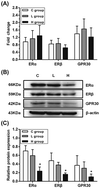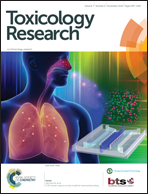Roles of ERK1/2 and PI3K/AKT signaling pathways in mitochondria-mediated apoptosis in testes of hypothyroid rats
Abstract
The absence of the thyroid hormone (TH) could impair testicular function, but its mechanism is still rudimentary. This study aims to explore the roles of estrogen receptor (ER α, β) and G protein-coupled receptor 30 (GPR30), extracellular signal regulated kinase (ERK1/2) and phosphoinositide 3-kinase (PI3K)/protein kinase B (AKT) signaling pathways in apoptosis in testes of hypothyroidism rats. Male Wistar rats were randomly divided into control (C), low-(L) and high-hypothyroidism (H) groups [1 mL per 100 g BW per day normal saline, 0.001% and 0.1% propylthiouracil (PTU), respectively] by intragastrical gavage for 60 days. The levels of triiodothyronine (T3), thyroxine (T4) and thyroid stimulating hormone (TSH) in serum were measured. Expressions of ERα, ERβ and GPR30, pathway related protein expressions of ERK1/2 and PI3 K/AKT and apoptosis were detected in testicular homogenates. The results showed that T3 and T4 levels were decreased, and the TSH level was increased significantly in the H group. Protein expressions of ERα, ERβ and GPR30 decreased significantly in the H group. Significantly decreased protein expressions of p-ERK1/2, p-PI3K p85, p-AKT Ser473, Ras, p-Raf-1 Ser259, p-Raf-1 Ser338 and cyclin D1 in L and H groups as well PI3K p85, p-AKT and Thr308 in the H group were observed. Moreover, there was a significant increase in the Bad protein expression in L and H groups. In addition, there was a significant increase in the expression of Bax/Bcl-2, caspase 9 and cleaved caspase 3 and a significant decrease in the total caspase 3 protein expression in the H group. These results suggested that ERK1/2 and PI3K/AKT signaling pathways could be suppressed by hypothyroidism via inhibiting the expressions of ERs and could finally induce apoptosis in testes.



 Please wait while we load your content...
Please wait while we load your content...